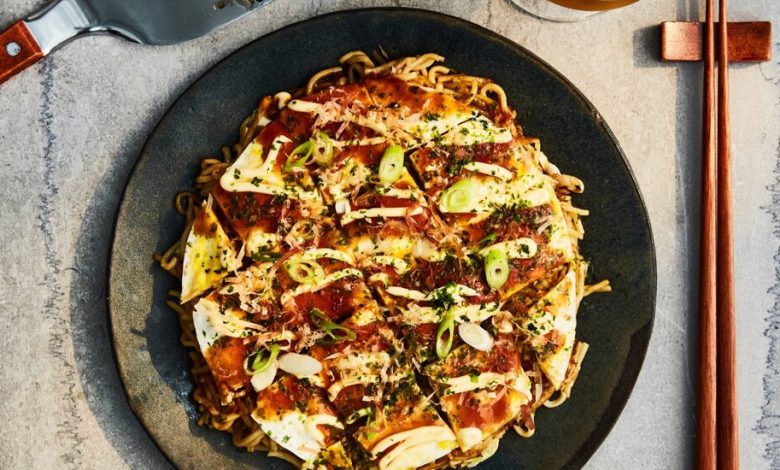A Japanese Pancake That Wastes Nothing and Saves Everything

About a decade ago — after an adult sleepover — I had my first bites of okonomiyaki, in a man’s walk-up apartment not far from Osaka’s Namba train station. I’d only just gotten used to the city’s drowsy mornings. My chef, an older guy with even sleepier eyes than mine, had seemingly every ingredient but the one he was looking for, grumbling as he chopped, stirred, ladled and fried our batter. But everything he did have went into the pancakes. And every bite tasted like something else — unexpected.
Recipe: Hiroshima-Style Okonomiyaki
As he watched me chew, I told him I’d never eaten anything like it, and he made a grin that I took as snark at the time: Nothing about this was special. It was, he shrugged, very ordinary.
The dish’s DNA stuck with me, though: Okonomiyaki translates from Japanese as “whatever you want, fried.” Flour, water, cabbage. Seasoning. A porky component or maybe another protein, with variation upon variation. Early on, for me, this proved to be a boon and a curse. I was still figuring out what I liked, and why.
But almost by accident, I was made aware: A Tokyo friend, cooking with a newborn in her arm, flipped a bare-bones cabbage pancake while I made faces at her kid. There was the version eaten during a downpour, at a dinky izakaya in Chicago. And a recipe cooked upon learning about the overdose of a friend in Los Angeles. A version cooked for my mother after a calamitous evening, rain-soaked and driving across Houston. A bundle of latkes cooked in another friend’s Berkeley apartment, topped with bonito flakes and Kewpie mayo, which we christened okonomiyaki.
The only things they shared were the name and the feeling. It was all okonomiyaki. All very much itself.
But what really knocks me over is okonomiyaki’s resemblance to writing — everything goes in it. And there’s still a form. An arc and a rhythm. Three years ago, my new novel, “Family Meal,” started with two guys sharing the dish in a kitchen, a little in love with each other and no place to put it but a cabbage pancake. I threw everything in that draft. Wrote 10,000 words. Then a pandemic began, and I immediately threw all of them out. None of that felt as if it mattered, except for the deliciousness. The kitchen remained — wooden stools against the counter — with dingy light and brushed hands, but I didn’t know where to put it.
Months passed. I ate okonomiyaki: the only thing my stomach could stand the first few weeks of Covid isolation. The only thing to settle my nerves after the uprisings a few months later. And then a version shared among friends, at a long-delayed reunion, on a patio in Oakland. A recipe I cooked during months of medical testing, for kidney pain, lying through M.R.I. after M.R.I. A recipe eaten after learning, upon returning from a queer club, about a shooting at another queer club mere states away. A recipe shared in Kyoto months later, mellowed on sake, sleepy in a yukata, eaten by hand from a single plate.
In every meal we touch reside the dishes we’ve cooked before. Nothing is wasted. The first scene of “Family Meal” — the shared okonomiyaki, a quiet kitchen — became the last. Now I’m lost in another book, throwing more words out, and this will be my last Eat column.
But it could be, I think, that okonomiyaki has become a sort of home for me. Wherever its ingredients — cabbage, flour, water — can be found, you can conjure an abode. Some of us have the chance to build our own homes. Some of us lose them. And some of us find others looking for theirs, too, and we settle somewhere comfortable together. Seeing how much things can change, and what can be rebuilt with the pieces, is proof that we can change our lives as many times as we need to.
If we’re lucky though, even if only for a little while, some things stay the same. A few weeks back, after missing a train, I ended up in Osaka’s Kote, a tiny okonomiyaki spot alongside the local line. Three regulars huddled at the bar, while a single chef worked behind a griddle in sweatpants. His motions belonged to him, but I’d seen them countless times. When he set my plate on the table, the okonomiyaki was simple and could’ve been made in anyone’s home: which is to say that it looked beautiful. I told him so.
But he, too, grinned. Ah, he said. No. Not so special.
And I agreed — he was right. Not so special after all.
Except now I knew — I know — that this, too, is a blessing.
Recipe: Hiroshima-Style Okonomiyaki




